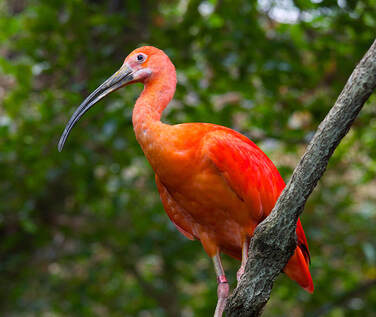Scarlet Ibis (Eudocimus ruber)

Common Name: Scarlet Ibis
Scientific Name: Eudocimus ruber
Physical Description: They stand 21½ – 27½ inches tall and have a wingspan of about 38 inches. Their long, down-curved bill is pink-brown to black in color and is used to probe the mud for food. Males are larger than females and weigh 1 lb. 6.5 oz on average while females weigh 1 lb. 5 oz. The bright pink-orange feathers get their color from the crustaceans the ibis eat. The Zoo’s ibis have a special diet that includes food items with this pigment. If the diet changes, the new feathers that grow in after the bird molts will show signs of fading color.
Habitat: The Scarlet Ibis lives in mangrove swamps, muddy estuaries, and tidal flats.
Range: They can be found in northern Venezuela, Brazil, Central America, the southern United States of America, and a small area in Africa south of the Sahara.
Diet: They eat fiddler crabs, aquatic insects, fish, snails, green algae, and other small animals.
Lifespan: They live 7 years on average.
Social Structure: Nesting usually takes place during the rainy season (May and June). The nest is constructed of loosely placed sticks that the male brings to the female. She will lay 2-3 dull olive-green to buff colored eggs and incubate them for 21 – 23 days. The nestlings begin to climb around in the trees when they are 2-3 weeks. They will be able to fly around 28 days.
Status: Least Concern1
Other: Their greatest danger is human disturbance at their nesting areas. Once disturbed they may leave the nesting area, therefore producing fewer chicks. The birds are also collected for their meat and feathers.
1 https://www.iucnredlist.org/species/22697415/93612751
Scientific Name: Eudocimus ruber
Physical Description: They stand 21½ – 27½ inches tall and have a wingspan of about 38 inches. Their long, down-curved bill is pink-brown to black in color and is used to probe the mud for food. Males are larger than females and weigh 1 lb. 6.5 oz on average while females weigh 1 lb. 5 oz. The bright pink-orange feathers get their color from the crustaceans the ibis eat. The Zoo’s ibis have a special diet that includes food items with this pigment. If the diet changes, the new feathers that grow in after the bird molts will show signs of fading color.
Habitat: The Scarlet Ibis lives in mangrove swamps, muddy estuaries, and tidal flats.
Range: They can be found in northern Venezuela, Brazil, Central America, the southern United States of America, and a small area in Africa south of the Sahara.
Diet: They eat fiddler crabs, aquatic insects, fish, snails, green algae, and other small animals.
Lifespan: They live 7 years on average.
Social Structure: Nesting usually takes place during the rainy season (May and June). The nest is constructed of loosely placed sticks that the male brings to the female. She will lay 2-3 dull olive-green to buff colored eggs and incubate them for 21 – 23 days. The nestlings begin to climb around in the trees when they are 2-3 weeks. They will be able to fly around 28 days.
Status: Least Concern1
Other: Their greatest danger is human disturbance at their nesting areas. Once disturbed they may leave the nesting area, therefore producing fewer chicks. The birds are also collected for their meat and feathers.
1 https://www.iucnredlist.org/species/22697415/93612751
Rainforest Building open daily from 10:30 am to 3:30 pm






